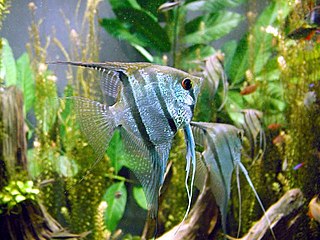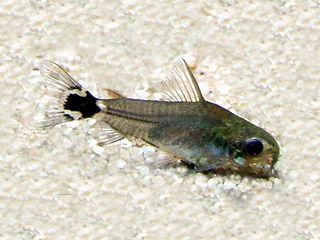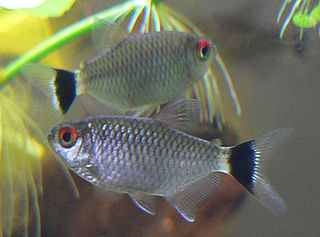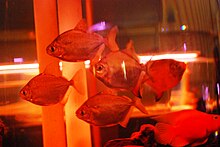
The neon tetra is a freshwater fish of the characin family of order Characiformes. The type species of its genus, it is native to blackwater and clearwater streams in the Amazon basin of South America. Its bright colouring makes the fish visible to conspecifics in the dark blackwater streams, and is also the main reason for its popularity among freshwater fish hobbyists, with neon tetras being one of the most widely kept tropical fish in the world.

The cardinal tetra is a freshwater fish of the family Characidae of order Characiformes. It is native to the upper Orinoco and Negro Rivers in South America. Growing to about 3 cm (1.2 in) total length, the cardinal tetra has the striking iridescent blue line characteristic of the genus Paracheirodon laterally bisecting the fish, with the body below this line being vivid red in color, hence the name "cardinal tetra". The cardinal tetra's appearance is similar to that of the closely related neon tetra, with which it is often confused; the neon's red coloration extends only about halfway to the nose, and the neon's blue stripe is a less vibrant blue.

The black phantom tetra, or simply phantom tetra, is a small freshwater fish of the characin family (Characidae) of order Characiformes. It is native to the upper Paraguay basin and upper Madeira basin in Brazil and Bolivia. It is commonly seen in the aquarium trade.

Pterophyllum is a small genus of freshwater fish from the family Cichlidae known to most aquarists as angelfish. All Pterophyllum species originate from the Amazon Basin, Orinoco Basin and various rivers in the Guiana Shield in tropical South America. The three species of Pterophyllum are unusually shaped for cichlids being greatly laterally compressed, with round bodies and elongated triangular dorsal and anal fins. This body shape allows them to hide among roots and plants, often on a vertical surface. Naturally occurring angelfish are frequently striped transversely, colouration which provides additional camouflage. Angelfish are ambush predators and prey on small fish and macroinvertebrates. All Pterophyllum species form monogamous pairs. Eggs are generally laid on a submerged log or a flattened leaf. As is the case for other cichlids, brood care is highly developed.

The skunk loach, skunk botia or Hora's loach is a species of botiid loach found in the Mekong River basin in Indochina, as well as the Chao Phraya and Mae Klong basins in Thailand. The maximum size is 10 cm (4 in) and it occurs in water with parameters 26 - 30 °C temperature, pH 6.0 to 8.0, hardness 5.0 to 12.0. It feeds on live crustaceans, insects, snails and other invertebrates.

The Congo tetra is a species of fish in the African tetra family, found in the central Congo River Basin in Africa. It is commonly kept in aquaria.

The dwarf gourami is a species of gourami native to South Asia.

The dwarf corydoras, dwarf catfish, tail spot pygmy catfish, or micro catfish is a tropical freshwater fish belonging to the subfamily Corydoradinae of the family Callichthyidae. It originates in inland waters in South America, and is found in the Amazon River and Paraguay River basins in Argentina, Bolivia, and Brazil. The specific epithet hastatus means with a spear, in reference to the spearhead-like spot on the tail root.

The lemon tetra is a species of tropical freshwater fish which originates from South America, belonging to the family Characidae. It is a small tetra growing to 5 cm (2 in) in length. The species is a long established favourite aquarium fish, being introduced to the aquarium in 1932.

The rummy-nose tetra is a species of tropical freshwater characin fish originating in South America, popular among fishkeepers as a tropical aquarium fish. One of many small tetras belonging to the same genus, it is on average 5 cm (2 in) long when fully grown. The fish is one of several very similar species including Petitella bleheri, and Petitella georgiae, and it is possible that more recently collected specimens available in the aquarium trade are members of one or other of these similar species. The common name applied to most of these fishes is "rummy-nose tetra", though other common names are in circulation.
The bloodfin tetra is a species of characin from the Paraná River basin in South America. The bloodfin is a relatively large tetra, growing to 5.5 cm. Its notable feature is the blood-red colouration of the tail, dorsal, anal and adipose fin, while the body is silver in color.

Hemigrammus erythrozonus, commonly known as the glowlight tetra, is a small tropical fish from the Essequibo River, Guyana, South America. It is silver in colour and a bright iridescent orange to red stripe extends from the snout to the base of its tail, the front of the dorsal fin being the same color as the stripe. Other fins are silver to transparent. The glowlight tetra is a peaceful, shoaling fish. It is larger than the neon tetra, and its peaceful disposition makes it an ideal, and popular, community tank fish. It should be kept with similar sized, non-aggressive species. Hemigrammus gracilis is a senior synonym. The red-line rasbora of Malaysia and Indonesia has markings and coloring very similar to H. erythrozonus, but is a member of family Cyprinidae, not a close relative.

The butterfly splitfin or butterfly goodeid is a bony fish from the monotypic genus Ameca of the splitfin family (Goodeidae). It was formerly found throughout the Ameca River drainage in Mexico; the type locality is Rio Teuchitlán in the vicinity of Teuchitlán, Jalisco. The species was only ever found in an area about 10 miles (15 km) in diameter.

The blackline rasbora is a fish of the family Cyprinidae found in Asia in the Mekong, Chao Phraya, and Mae Klong basins, and also the northern Malay Peninsula. In the aquarium trade, it is known by a variety of other names, including red-tailed rasbora, bora bora rasbora, and brilliant rasbora.

The redeye tetra, is a species of tetra from the São Francisco, upper Paraná, Paraguay and Uruguay river basins in eastern and central South America. This freshwater fish is commonly kept in aquariums and bred in large numbers at commercial facilities in Eastern Europe and Asia. The redeye tetra is one of the more popular aquarium fish due to their schooling capability.

The ember tetra is a freshwater fish of the characin family of order Characiformes. It is native to the Araguaia River basin of Brazil and was discovered in 1987 and named in honor of the fish explorer Heiko Bleher's mother.

Nematobrycon palmeri, commonly known as the emperor tetra, is a species of characid fish found in the Atrato and San Juan river basins in western Colombia. It was first imported in the aquarium trade to the United States in 1960 and has since become well established.

The White Cloud Mountain minnow is a hardy species of freshwater fish and coldwater fish often kept in an aquarium. The species is a member of the carp family of the order Cypriniformes, native to China. The White Cloud Mountain minnow is practically extinct in its native habitat, due to pollution and tourism. It was believed to be extinct for over 20 years in 1980, but an apparently native population of this fish was discovered on Hainan Island, well away from the White Cloud Mountain. They are bred in farms and are easily available through the aquarium trade. However, inbreeding in farms has led to genetically weak stock that is vulnerable to disease and prone to physical deformities.
Hyphessobrycon heterorhabdus, commonly known as the flag tetra or Belgian flag tetra, is a species of freshwater characin fish endemic to Brazil. Belonging to the family Characidae, this species is distinguished by its vibrant coloration and patterns, which have contributed to its popularity in the aquarium trade.
Iguanodectes spilurus, the green-line lizard tetra, is a small characiform fish from the rivers of South America. It is not a well-studied species, but research is available, including data from hobbyists that keep it as an ornamental fish. It has a distinct lateral stripe of reflective-green scales, and lacks any red markings therein; red is common in congeners' lateral stripes.


















